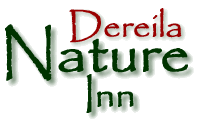 ___ ___
Welcome to our monthly celebration of nature and photography!
THIS MONTH:
» Quiz - Some Mighty Beasts!
» Five Things About... Butterflies
» Names of groups of birds
|
|
|
 |
Barnacles, whelks and chitons remind us to go exploring!
This month brings us the low tides and the chance to see many of these animals.
|
|
 |
Where's Lily?
While you're reading this month, be sure to keep an eye out for Lily the Ladybug.
She's managed to hide in one of the photos, but which one?! |
|
|

Which wildflower contains a chemical that speeds the formation of blood clots on wounds?
Compare your answer with the answer at the end of the newsletter.
|

 |
Here's a close-up image to test your mystery-solving skills.
As usual, you'll find the answer at the end of the newsletter.
|
|
|
|
Grab a piece of paper and test yourself by identifying these amazing and mighty beasts. |
| |
|
|
|
|
Number 1 |
|
Number 2 |
 |
a. Grizzly Bear
|
_ |
 |
a. American Elk |
b. Yogi Bear
|
|
b. Moose |
c. Brown Bear
|
|
c. White-tailed Deer |
| d. Black Bear |
|
d. Mule Deer |
| |
|
|
|
|
Number 3 |
|
Number 4 |
 |
a. Gray Wolf |
|
 |
a. American Elk
|
b. Coyote
|
|
b. Moose
|
c. Red Fox
|
|
c. Caribou |
| d. Wile E. Coyote |
|
d. Mule Deer |
| |
|
|
|
|
Number 5 |
|
Number 6 |
 |
a. American Elk
|
|
 |
a. Caribou |
b. Moose
|
|
b. American Elk |
c. Caribou
|
|
c. White-tailed Deer |
| d. Mule Deer |
|
d. Mule Deer |
| |
|
|
|
|
Number 7 |
|
Number 8 |
 |
a. Caribou
|
|
 |
a. Coyote |
b. American Elk
|
|
b. Canadian Wolf |
c. White-tailed Deer
|
|
c. Gray Wolf |
| d. Mule Deer |
|
d. American Wolf |
| |
See how well you did by checking your answers later in the newsletter! |
| |
|
|
|
|
|

Demonstrate your wisdom and nature know-how by throwing
a few fascinating nature words into your daily conversations! |
| |
| I was surprised to read that 60% of the planet's birds belong to a group called passerines. A passerine is |
| |
a. a bird that migrates. |
| |
b. an insect-eating bird. |
| |
c. a perching bird. |
| |
d. a sea bird. |
| |
| |
You'll find the answer at the end of this month's Whispers.
|
|

 |
Did you know that this photograph shows a whorled cluster? It's one of several different ways that flowers are arranged.
On top of this, the flowers in a cluster come in a variety of shapes. For example, some look like a bell and others like a funnel.
As we move into a great time of the year for viewing wildflowers, we thought it would be a super time to feature our page: Flower Shapes and Clusters.
|
|
|
|
__ |
|
Jim Noeninger of Shiloh, Illinois was fortunate to take some exciting photographs of some Bald Eagles.
Jim had a good time with the eagles co-operating and posing for him! |
| |
|
|
|
|
|
This beautiful Silver-spotted Skipper, Epargyreus clarus, comes from Dennis Coop of Sherwood, Arkansas. |
|
Here's a very happy looking Great Blue Heron with a yummy lunch, spotted by Gail Freiherr of Knoxville, TN |
| |
|
|
 |
W. C. Durnil of Chino Valley, Arizona, captured this lovely picture of a young deer having a bite to eat. |
|
Thank you Jim, Dennis, W.C. and Gail for the fabulous photographs
and for
taking the time to send them in for us all to enjoy. We really appreciate it.
If you have a nature image you'd like to see in this section, please let us know!.
|
|

|
This month we wandered around and came upon a very special secret place created by a pair of Killdeers. |
|
|

Do you have an idea for a fun caption for this photo of two Goldeneyes?
|
|
Here are some ideas:
#1 - "Wow! You won't believe what's down here."
#2 - " Hey! Why don't you watch where you're going?"
If this month's photo inspires you, please send us your caption in an e-mail.
|
|

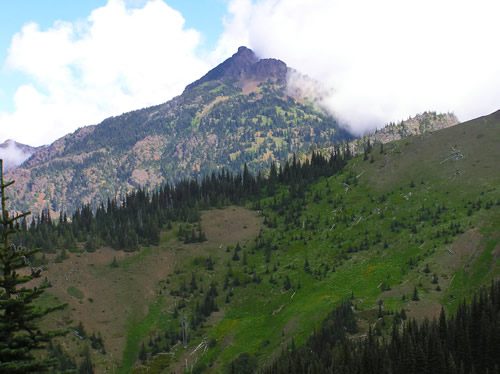 |
In Olympic National Park, Washington, is an extraordinary and easily accessed place: Hurricane Ridge. As its name implies, it can be quite stormy here however it is noted for its wonderful alpine wildflowers. |
|
|

___Enjoying a lazy day in the sun, a young snake slithered over to his mother.
___"Mom," he asked, "are we poisonous?"
___"No son," replied mother snake. "Why do you ask?"
___The young son answered, "Because I just bit myself."
|
|
|
"Thank goodness for that as I was worried for a while."
Thanks to Sheila in Victoria who sent in this joke for us. |
| |
|

Here are this month's choices:
Bird - Olive-sided Flycatcher | Wildflower - Purple Sanicle | Bug - Coelioxys rufitarsis
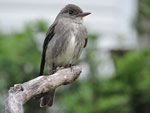 __ __ 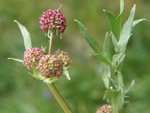 __ __
Click on the images to visit the pages.
| A Little Reminder |
 |
With the spring comes a few new family members and they sometimes wander on to the roads. Please stay alert for these young 'uns. |
|
|
Tips and Ideas |
|
The cheapest place to find these suet blocks is your local dollar store. We use them to make our home-made suet go a bit further. When your favourite recipe is ready for pouring into a tray, melt the store-bought block in the microwave and add it to your mix. |
| |
|
Here is a favourite home-made suet recipe from our Recipe Collection that lots of bird, especially these Bushtits, really enjoy.
|
| Ingredients: |
| |
1/2 cup lard
1/2 cup suet (usually found in the supermarket's frozen pies/pastry section)
1 cup peanut butter
1 cup flour
1 cup oats
1 cup cornmeal
handful of birdseed (optional)
dried eggshells - roll them out with a rolling pin until they are like dust (optional) |
| |
|
| Method: |
| |
Melt lard, suet and peanut butter in the microwave until soft and runny.
Add remaining ingredients and let cool a bit.
Before it's too solid, pour into moulds or place in suet holders - or - better yet put into a pine cone. |
| |
|
About Birds: Bird Group Names - Part One
|
Picture of the Week
 |
|
Be sure to drop by the Inn every week to see the latest Picture of the Week.
You can also do so by clicking on the image to the left or by clicking here. |
|
| |
|
| |
Past Issues
If you want to see any of the past issues of Whispers, they are available here.
|
|
|
 |
|
 |
|
|
National Pollinator Week is a time to celebrate and acknowledge the importance of the pollinating birds, insects and other animals.
Click here for more information.
|
|

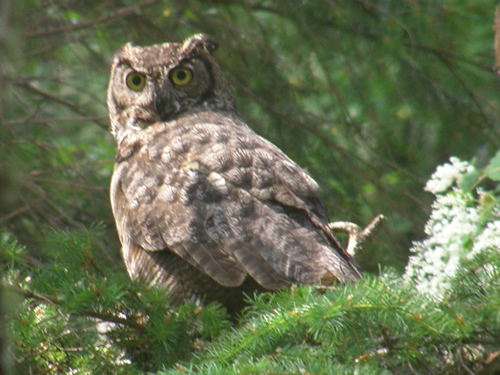 |
Did you know that the colour of an owl's eyes can tell you when it hunts?
Owls with yellow eyes hunt mainly during the day.
|
|
|
Owls with dark eyes hunt during the night and those with orange eyes hunt at dusk or dawn.
|
|

 |
The delicious Blackberry is Kentucky's state fruit. |
| |
|

|
Yarrow has many healing properties including stopping the flow of blood from wounds. |
|
|

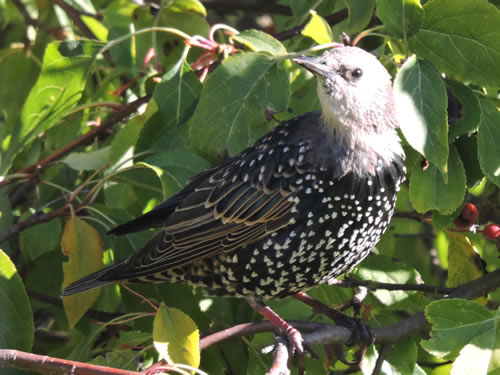 |
This month's mystery image is a European Starling.
|
| |
|

|
A passerine is
c. a perching bird.
Most passerines are also songbirds and many will visit your bird-feeding station. |
| |
|

 |
__ |
 |
__ |
 |
__ |
 |
1 - d. Black Bear
|
|
2 - d. Mule Deer |
|
3 - b. Coyote |
|
4 - a. American Elk
|
| |
|
|
|
|
|
|
|
|
|
|
|
|
|
5 - b. Moose
|
|
6 - a. Caribou |
|
7 - c. White-tailed Deer |
|
8 - c. Gray Wolf |
|
|
|
|
 |
Still looking for Lily?
If you need a little clue, click here! |
| |
| |
|
Thanks for joining us this month. We hope you enjoyed this issue of Whispers. We invite your comments and ideas - just drop us an e-mail. See you next month! |
|